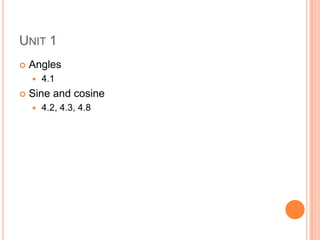
Trigonometry
- 1. UNIT 1 Angles 4.1 Sine and cosine 4.2, 4.3, 4.8
- 2. HOW TO MEASURE IN BOTH DEGREES AND RADIANS A degree is a measurement you use in angles. One way that you can get an angle is using sine, cosine, or tangent inverse. A radian is when the measure is 1 radian for the central angle of a circle if it shows an arc with the same length like the radius.
- 3. KNOW THE CONVERSION BETWEEN DEGREES AND RADIAN MEASURE To convert radians to degrees, you have to multiply 180÷π radians Example- 3 π rad × 180° (3/4)×180= 135° 4 π rad To convert degrees to radians, you must multiply π radians÷180 Example- 60° × π rad =60 π rad= π/3 rad 1 180° 180°
- 4. THEIR GRAPHS AS FUNCTIONS AND THE CHARACTERISTICS
- 5. THEIR DEFINITION AS X- & Y-COORDINATES ON THE UNIT CIRCLE Sine=y Cosine=x Example: 5π/6 is equal to 150° and the point is (-√3/2,1/2) Sine would equal 1/2 , while cosine equals -√3/2
- 6. STUDENTS ARE CAPABLE OF COMPUTING UNKNOWN SIDES OR ANGLES IN A RIGHT TRIANGLE. In order to find a side of a right triangle you can use the Pythagorean Theorem, which is a^2+b^2=c^2. The a and b represent the two shorter sides and the c represents the longest side which is the hypotenuse. Example- if you have to sides with the measurement of 3 and 5 and you are trying to fine the hypotenuse then you would use the formula 3^2+5^2=c^2 . You will get 9+25=c^2 and then 34=c^2 and you would have to square both sides and you get the hypotenuse (c) To get the angle of a right angle you can use sine, cosine, and tangent inverse. They are expressed as tan^(-1) ,cos^(-1) , and sin^(-1) . Example- if you want to fine the angle across from three on the right angle above then you would use tangent inverse. It would be tan A=3/5 and then you multiply both sides by tan^(-1) and you get tan^(-1) 〖 (3/5)〗. You put that in the calculator and you get side A.
- 7. STUDENTS USE TRIGONOMETRY IN A VARIETY OF WORDS PROBLEMS. Example- “Suppose you are standing on one bank of a river. A tree on the other side of the river is known to be 150 ft. tall. A lone from the top of the tree to the ground at your feet makes an angle of 11° with the ground. How far from you is he base of the tree?” (x)tan11°=150/x (x) .19x/.19=150/.19 150 ft x=789.47 ft. 11° x Word problems are expressed to show real life situations. Word problems are usually more difficult than a problem from the actual lesson. The word problems we do are the same as the problems we usually do but it just requires more thinking.
- 8. UNIT 2 Functions of the form f(t)=A sin (Bt + C) & f(t)=A cos (Bt + C): 4.4, 4.5, 4.7, 4.8
- 9. PROPERTIES: AMPLITUDE, FREQUENCY, PERIOD AND PHASE SHIFT (A, B & C)
- 10. STUDENT WILL BE ABLE TO TAKE A GIVEN ANGLE AND COMPUTE THE TRIGONOMETRIC FUNCTION AND ITS INVERSE WITH THE AID OF THE UNIT CIRCLE (BY HAND)
- 11. STUDENTS USE TRIGONOMETRY IN A VARIETY OF WORD PROBLEMS. “When sitting atop a tree and looking down at his pal Joey, the angle of depression of Mack’s line of sight is 38°32’. If joey is know to be standing 39 feet from the base of the tree, how tall is the tree ? h 39 ft 38°32’ First you must convert the 32 into degrees so you divide it by 60 and then add it to 38 and you get 38.5°. Then to get the height you have to use tangent and you use tan38.5°=h/39 and you get the height of the tree to be approximately 31 ft.
- 12. UNIT 3 Analytical Trigonometry 5.1, 5.2, 5.3, 5.4 5.5, 5.6
- 15. SUM AND DIFFERENCE FORMULAS
- 16. USE DOUBLE-ANGLE AND HALF-ANGLE FORMULAS TO PROVE AND/OR SIMPLIFY OTHER TRIGONOMETRIC IDENTITIES.
- 17. STUDENTS WILL BE FAMILIAR WITH THE LAW OF SINES AND LAW OF COSINES TO SOLVE PROBLEMS
- 18. UNIT 4 Applications of Trigonometry 6.1, 6.2, 6.3, 6.4, 6.5
- 19. STUDENTS NEED TO KNOW HOW TO WRITE EQUATIONS IN RECTANGULAR COORDINATES IN TERMS OF POLAR COORDINATES
- 21. VECTORS-ADDITION AND SCALAR MULTIPLICATION U=(u1,u2), v=(v1,v2) are vectors. When you are adding you use the formula u+v=(u1+v1,u2,v2). K is known to be a real number and you would use it to multiply with the formula ku=k(u1,u2)=<ku1,ku2>. Example- let u=<-1,3> and v=<4,7> and add the vectors. u+v=(-1,3)+(4,7)=(-1+4,3+7) <-3,10> All you have to do is add the first number from each point to get the x and add the second number from each point together to get the y. Example- use scalar multiplication to find 3u when u=<-1,3>. Since there is a 3 before the u, you have to multiply each number in the point by three. 3u=3(-1,3)=(-3,9)
- 22. VECTORS-RESOLVING THE VECTOR The formula v=(|v|cosƟ,|v|sinƟ) can be used when v has a direction angle Ɵ and the components of v can be calculated. The unit vector in the direction of v is u=v/|v|=(cosƟ,sinƟ). Example- “find the components of vector v with direction angle 115 and magnitude 6.” All you have to do is substitute 6 which is the magnitude into the equation wherever there is a v. Also plug in 115 wherever there is a Ɵ. V=(a,b)=(6cos115 ,6sin115 ) a would be approximately - 2.54 while b would be about 5.44
- 24. VECTORS-ANGLE BETWEEN TWO VECTORS
- 25. PARAMETRIC RELATIONS x y t -6 -6 -3 -1 -4 -2 2 -2 -1 3 0 0 2 2 1 -1 4 2 -6 6 3